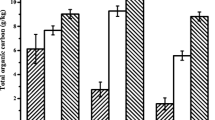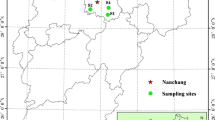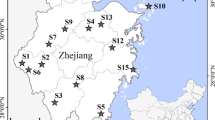Abstract
It is recognized that for successful establishment of a vegetation cover on bauxite residue disposal areas, soil formation and a greater understanding of the processes of soil development are crucial. The stability of microaggregates is a very important physical property that prevents erosion in bauxite residues. Samples were collected from a disposal area in Central China to determine not only the mechanism of aggregation but also clay dispersion. Colloidal stability was assessed by determining organic matter, carbonate, electrolyte, clay mineral, and iron-aluminum oxide forms, as these would contribute to their stability. Organic matter improved microaggregate stability by combining with clay particles and polyvalent cations to form macroaggregates. Polyvalent cations such as calcium had a positive effect on particle flocculation, while organic molecules were more effective at stabilizing microaggregates. Removal of salinity dispersed silt-size aggregates into clay-size aggregates and reduced microaggregate stability. Calcium improved particle aggregation, while sodium had the reverse effect. Quartz powder was added to the residues but did not show any cementing effect, while free and amorphous iron-aluminum oxides were effective binding agents for microaggregate formation. We propose that the presence of organic matter and polyvalent cations, together with incorporation of organic carbon and calcium minerals, may enhance the stability of this material and prove beneficial toward improving its physical condition.


Similar content being viewed by others
References
Alperovitch N, Shainberg I, Keren R (1981) Specific effect of magnesium on the hydraulic conductivity of sodic soils. Eur J Soil Sci 32:543–554
Amézketa E (1999) Soil aggregate stability: a review. J Sustain Agr 14:83–151
Amézketa E, Carranza R, Urgel B, Lafarga RA (2003) Chemical, spontaneous and mechanical dispersion of clays in arid-zone soils. Span J Agric Res 1(4):95–107
Armstrong ASB, Tanton TW (1992) Gypsum applications to aggregated saline-sodic clay topsoils. Eur J Soil Sci 43:249–260
Arora HS, Coleman NT (1979) The influence of electrolyte concentration on flocculation of clay suspensions. Soil Sci 127:134–189
Bronick CJ, Lal R (2005) Soil structure and management: a review. Geoderma 124:3–22
Cammeraat LH, Imeson AC (1998) Deriving indicators of soil degradation from soil aggregation studies in southeastern Spain and southern France. Geomorphology 23:307–321
Chan KY, Heenan DP (1998) Effect of lime (CaCO3) application on soil structural stability of a red earth. Soil Res 36(1):73–86
Chauhan S, Ganguly A (2011) Standardizing rehabilitation protocol using vegetation cover for bauxite waste (red mud) in eastern India. Ecol Eng 37:504–510
Chen YY, Zhao WJ, Jia YG, Xu GH (2009) Effects of clay and organic matter on sediment microaggregate composition and its stability in tidal zone of Yellow River estuary. Mar Geol Quat Geol 29(1):31–37 in Chinese
Clough A, Skjemstad JO (2000) Physical and chemical protection of soil organic carbon in three agricultural soils with different contents of calcium carbonate. Aust J Soil Res 38:1005–1016
Courtney R, Kirwan L (2012) Gypsum amendment of alkaline bauxite residue—plant available aluminium and implications for grassland restoration. Ecol Eng 42:279–282
Courtney RG, Jordan SN, Harrington T (2009) Physico-chemical changes in bauxite residue following application of spent mushroom compost and gypsum. Land Degrad Dev 20(5):572–581
Courtney R, Harrington T, Byrne KA (2013) Indicators of soil formation in restored bauxite residues. Ecol Eng 58:63–68
Duiker SW, Rhoton FE, Torrent J, Smeck NE, Lal R (2003) Iron (hydr)oxide crystallinity effects on soil aggregation. Soil Sci Soc Am J 67:606–611
Gräfe M, Klauber C (2011) Bauxite residue issues: IV. Old obstacles and new pathways for in situ residue bioremediation. Hydrometallurgy 108:46–59
Hind AR, Bhargava SK, Grocott SC (1999) The surface chemistry of Bayer process solids: a review. Colloid Surface A 146:359–374
Huang L, Wang CY, Tan WF, HQ H, Cai CF, Wang MK (2010) Distribution of organic matter in aggregates of eroded Ultisols, Central China. Soil Till Res 108:59–67
Igwe CA, Zarei M, Stahr K (2009) Colloidal stability in some tropical soils of southeastern Nigeria as affected by iron and aluminium oxides. Catena 77:232–237
Jones BEH, Haynes RJ (2011) Bauxite processing residue: a critical review of its formation, properties, storage, and revegetation. Crit Rev Env Sci Tec 41:271–315
Jones BEH, Haynes RJ, Phillips IR (2011) Influence of organic waste and residue mud additions on chemical, physical and microbial properties of bauxite residue sand. Environ Sci Pollut R 18:199–211
Klauber C, Gräfe M, Power G (2011) Bauxite residue issues: II. Options for residue utilization. Hydrometallurgy 108(1–2):11–32
Levy GL, Stern R, Agassi M, Smith HJC (1993) Microaggregate stability of kaolinitic and illitic soils determined by ultrasonic energy. Soil Sci Soc Am J 57:803–808
Liu S, Kang Y, Wan S, Wang Z, Liang Z, Sun X (2011) Water and salt regulation and its effects on Leymus chinensis growth under drip irrigation in saline-sodic soils of the Songnen Plain. Agr Water. Manage 98:1469–1476
Liu WC, Chen XQ, Li WX, YF Y, Yan K (2014) Environmental assessment, management and utilization of red mud in China. J Clean Prod 84:606–610
Mbagwu JSC, Auerswald K (1999) Relationship of percolation stability of soil aggregates to land use, selected properties, structural indices and simulated rainfall erosion. Soil Till Res 50:197–206
Metreveli G, Philippe A, Schaumann GE (2014) Disaggregation of silver nanoparticle homoaggregates in a river water matrix. Sci Total Environ 535:35–44
Miller WP, Frenkel H, Newman KD (1990) Flocculation concentration and sodium/calcium exchange of kaolinitic soil clays. Soil Sci Soc Am J 54(2):346–351
Opara CC (2009) Soil microaggregates stability under different land use types in southeastern Nigeria. Catena 79:103–112
Piccolo A, Mbagwu JSC (1990) Effects of different organic waste amendments on soil microaggregates stability and molecular sizes of humic substances. Plant Soil 123:27–37
Pinheiro-Dick D, Schwertmann U (1996) Microaggregates from Oxisols and Inceptisols: dispersion through selective dissolutions and physicochemical treatments. Geoderma 74:49–63
Power G, Gräfe M, Klauber C (2011) Bauxite residue issues: I. Current management, disposal and storage practices. Hydrometallurgy 108:33–45
Qadir M, Schubert S (2002) Degradation processes and nutrient constraints in sodic soils. Land Degrad Dev 13:275–294
Santini TC, Fey MV (2013) Spontaneous vegetation encroachment upon bauxite residue (red mud) as an indicator and facilitator of in situ remediation processes. Environ Sci Technol 47:12089–12096
Santini TC, Kerr JL, Warren LA (2015) Microbially-driven strategies for bioremediation of bauxite residue. J Hazard Mater 293:131–157
Six J, Bossuyt H, Degryze S, Denef K (2004) A history of research on the link between (micro)aggregates, soil biota, and soil organic matter dynamics. Soil Till Res 79:7–31
Sochan A, Bieganowski A, Ryżak M, Dobrowolski R, Bartmiński P (2012) Comparison of soil texture determined by two dispersion units of Mastersizer 2000. Int Agrophys 26:99–102
Tarchitzky J, Chen Y, Banin AS (1993) Humic substances and pH effects on sodium and calcium-montmorillonite flocculation and dispersion. Soil Sci Soc Am J 57:367–372
Ternan JL, Elmes A, Williams AG, Hartley R (1996) Aggregate stability of soils in Central Spain and the role of land management. Earth Surf Proc Land 21:181–193
Tisdall JM, Oades JM (1982) Organic matter and water-stable aggregates in soils. Eur J Soil Sci 33:141–163
Wang F, Pan G, Li L (2009) Effects of free iron oxyhydrates and soil organic matter on copper sorption-desorption behavior by size fractions of aggregates from two paddy soils. J Environ Sci (China) 21:618–624
Xue SG, Zhu F, Kong XF, Wu C, Huang L, Huang N, Hartley W (2016) A review of the characterization and revegetation of bauxite residues (red mud). Environ Sci Pollut R 23:1120–1132
Zanuzzi A, Arocena JM, van Mourik JM, Faz Cano A (2009) Amendments with organic and industrial wastes stimulate soil formation in mine tailings as revealed by micromorphology. Geoderma 154:69–75
Zhang XC, Norton LD (2002) Effect of exchangeable Mg on saturated hydraulic conductivity, disaggregation and clay dispersion of disturbed soils. J Hydrol 260:194–205
Zhang S, Li Q, Zhang X, Wei K, Chen L, Liang W (2012) Effects of conservation tillage on soil aggregation and aggregate binding agents in black soil of Northeast China. Soil Till Res 124:196–202
Zheng FL (2006) Effect of vegetation changes on soil erosion on the loess plateau. Pedosphere 16:420–427
Zhu F, Xue SG, Hartley W, Huang L, Wu C, Li X (2016a) Novel predictors of soil genesis following natural weathering processes of bauxite residues. Environ Sci Pollut R 23:2856–2863
Zhu F, Zhou JY, Xue SG, Hartley W, Wu C, Guo Y (2016b) Aging of bauxite residue in association of regeneration: a comparison of methods to determine aggregate stability & erosion resistance. Ecol Eng 92:47–54
Acknowledgments
Financial supports from Environmental protection’s special scientific research for Chinese public welfare industry (No. 201509048) and National Natural Science Foundation of China (No. 41371475) are gratefully acknowledged.
Author information
Authors and Affiliations
Corresponding author
Additional information
Responsible editor: Philippe Garrigues
Rights and permissions
About this article
Cite this article
Zhu, F., Huang, N., Xue, S. et al. Effects of binding materials on microaggregate size distribution in bauxite residues. Environ Sci Pollut Res 23, 23867–23875 (2016). https://doi.org/10.1007/s11356-016-7626-9
Received:
Accepted:
Published:
Issue Date:
DOI: https://doi.org/10.1007/s11356-016-7626-9




